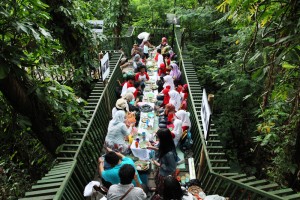Story of a City Forest
May 12, 2013 1 Comment
Not every city has a natural forest, moreover a World City Forest, like we have in Bandung: Babakan Siliwangi (BakSil). Now that we have one, what do we do with it? Merely disrupting it by replacing the trees with massive concrete buildings would be unimaginable, since that is the same as destroying the forest; but this is what seems to be the near future of BakSil City Forest if local people and communities do nothing about it.
Therefore, several communities have been holding events in this area to activate the idle space, while inviting more people to interact with the forest. Among the communities is Bandung Creative City Forum (BCCF), an independent organization that has previously hold two events to intervene BakSil. The first one was in 2011, during TUNZA: having BakSil declared as a World City Forest and building a canopy walk, presently called ForestWalk, at the premise. The second one was in 2012, with an event called Lightchestra as the opening of Helarfest2012: a three-days sound- and light-play in the forest, with an open-air concert of local indie bands, painting artists’ live performances, a photography contest, a paper lantern workshop for children, communities that perform best at night such as B.U.L.B. (Barudak Urban Light Bandung, a light graffiti community) and Bandung Urban Jedi; also collaborating with an environmental organization to limit and measure solid waste (food packaging, plastic bags, etc.) produced during the event.
This time, as the first 2013 program, BCCF held “Regia”, which aimed to refresh our relationship with our only city forest. The name “Regia” was taken from a dominant tree species that grows within the area, Delonix Regia, or Flamboyan in local name. During the two days of Regia, 20-21 April 2013, a lot of people gathered for various events, such as “Al-Fresco” or potluck picnic at the ForestWalk, children activities and games, open library, photo exhibition, morning yoga, forest dinner, live blues performance “Blues Leuweung” by several local blues musicians, and a discussion session about urban forest to close the series of event. An infographic, that was especially made for this event and was published in a regional newspaper and online social media, presents a number of facts about BakSil City Forest and how important it is for us.
From time to time, we need to celebrate our public space. Especially in a dense, growing city with substandard infrastructures like Bandung, whose inhabitants often need to take their own initiatives to improve their living environment.
After Regia, it seemed that there is hope that the company who has the developing right over BakSil would postpone its plan to build any commercial entity on the area. But our hope is yet again on trial, due to today’s update that the developer now has possessed permission to actually build a restaurant. Irritated as we are, we shouldn’t lose focus and conduct, within our capacity, smart responses to this issue. Let’s just make sure with all of our might that the story of our city forest continues for generations, onwards.
Related links:
Today’s news: the company is granted a permission to build on that area
Why we should care about our city forest
BCCF event announcement: REGIA
A photo essay by Galih Sedayu: on REGIA event
A photo essay by Galih Sedayu: about a series of graffiti that protests the commercialization of the city forest



